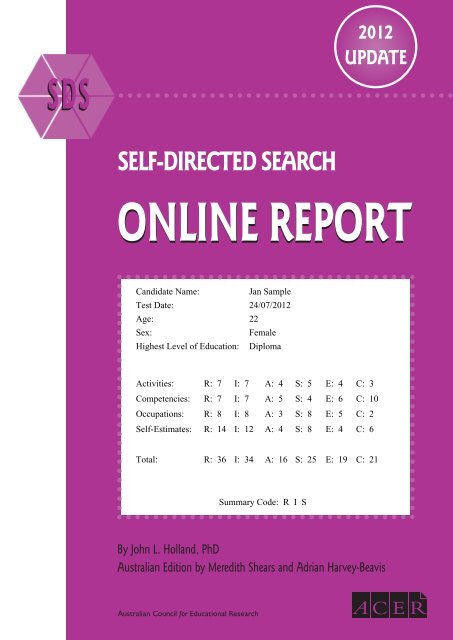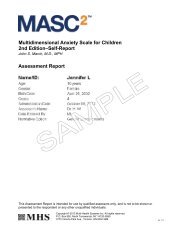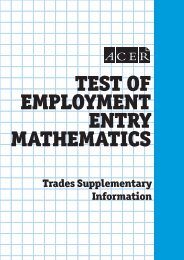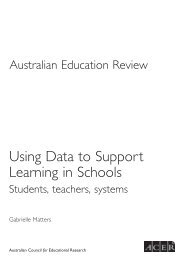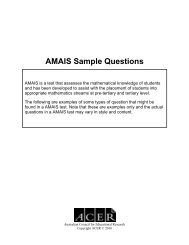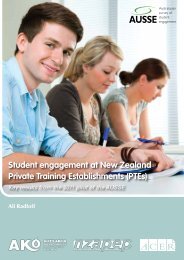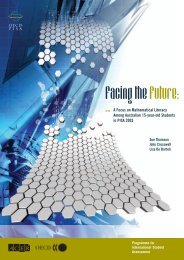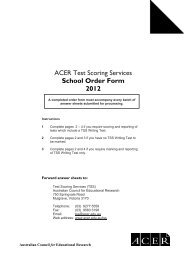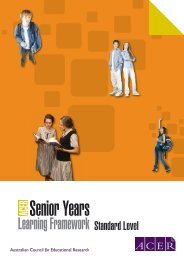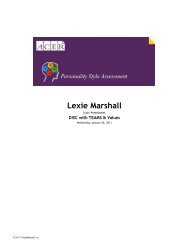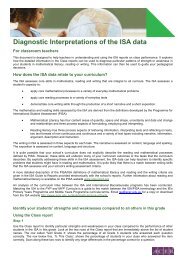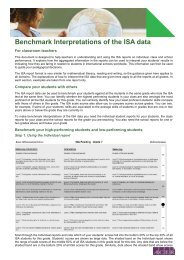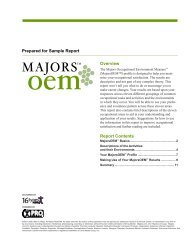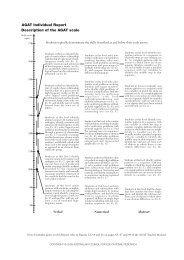SELF-DIRECTED SEARCH - ACER
SELF-DIRECTED SEARCH - ACER
SELF-DIRECTED SEARCH - ACER
You also want an ePaper? Increase the reach of your titles
YUMPU automatically turns print PDFs into web optimized ePapers that Google loves.
SDS<br />
<strong>SELF</strong>-<strong>DIRECTED</strong> <strong>SEARCH</strong><br />
ONLINE REPORT<br />
Candidate Name: Jan Sample<br />
Test Date: 24/07/2012<br />
Age: 22<br />
Sex: Female<br />
Highest Level of Education: Diploma<br />
Activities: R: 7 I: 7 A: 4 S: 5 E: 4 C: 3<br />
2012<br />
UPDATE<br />
Competencies: R: 7 I: 7 A: 5 S: 4 E: 6 C: 10<br />
Occupations: R: 8 I: 8 A: 3 S: 8 E: 5 C: 2<br />
Self-Estimates: R: 14 I: 12 A: 4 S: 8 E: 4 C: 6<br />
Total: R: 36 I: 34 A: 16 S: 25 E: 19 C: 21<br />
Summary Code: R I S<br />
By John L. Holland, PhD<br />
Australian Edition by Meredith Shears and Adrian Harvey-Beavis
2<br />
Introduction<br />
This report is based on your responses to the Self-Directed Search (SDS). The SDS is<br />
designed to help you explore career options. If you have already made up your mind about<br />
an occupation, it may support your idea or suggest other possibilities. If you are uncertain<br />
about what occupation to follow, the SDS may help you to locate a group of occupations<br />
for further consideration.<br />
A careful study of this report will help you to learn more about yourself, your job<br />
choices and your career. This report explains the ideas behind the SDS, how to use your<br />
codes and scores, provides occupations for you to explore and reviews some ideas for making<br />
good career decisions.<br />
Summary Codes<br />
The SDS was developed on the assumption that people can be loosely classified into six<br />
different groups or personality types: Realistic, Investigative, Artistic, Social, Enterprising<br />
and Conventional. The table on page 3 details the interests and characteristics of each of<br />
the six types.<br />
The SDS can be used to estimate how closely you resemble each of the types. Your scores<br />
are used to derive a three-letter Summary Code, where the first letter shows the type you<br />
resemble most, the second letter shows the type you resemble somewhat less and the third<br />
letter indicates the type you resemble less still. You resemble least of all the remaining<br />
three types. The Summary Code is a simple way of organising information about people<br />
and occupations. Although it is only an estimate, your Summary Code can be used to discover<br />
how your special pattern of interests, self-estimates and competencies resembles the<br />
patterns of interests and competencies that many common occupations demand. In this<br />
way, your Summary Code locates suitable groups of occupations for you to consider.<br />
Locate your Summary Code on the cover of this report and read about the types you<br />
resemble in the table on page 3. Then, use pages 7–23 to explore the occupational possibilities<br />
for all variations of your Summary Code. For example, a person with the Summary<br />
Code SIC would explore the categories SIC, SCI, ISC, ICS, CIS and CSI.<br />
<strong>SELF</strong>-<strong>DIRECTED</strong> <strong>SEARCH</strong> © 2001, 2012 AUSTRALIAN COUNCIL FOR EDUCATIONAL RE<strong>SEARCH</strong>
Interest types and special characteristics<br />
Realistic Investigative Artistic Social Enterprising Conventional<br />
Keeping records and<br />
doing computations<br />
Holding a position of<br />
power<br />
Teaching or helping<br />
others<br />
Using artistic and<br />
creative talents<br />
Reading and thinking<br />
about solutions to<br />
problems<br />
Most enjoys Working with hands,<br />
tools, equipment and<br />
apparatus<br />
Producing a lot of work<br />
and being accurate<br />
Financial success, being<br />
influential in public<br />
affairs or having<br />
executive responsibility<br />
Helping others,<br />
sacrificing for others or<br />
being a competent<br />
teacher or therapist<br />
Becoming famous in<br />
performing arts, having<br />
written work published<br />
or producing original art<br />
Contributing to scientific<br />
theory and knowledge<br />
Life goals Making technical<br />
contributions to science<br />
Comfortable life,<br />
accuracy, politeness and<br />
thriftiness<br />
Ambition, freedom,<br />
financial success and<br />
risk-taking<br />
Equality, self-respect,<br />
helpfulness, forgiveness<br />
and freedom<br />
Imagination, creativity,<br />
beauty and selfexpression<br />
Values Self-control and honesty Intelligence, logic,<br />
achievement and<br />
knowledge<br />
Clerical ability and<br />
conservative orientation<br />
Popularity and<br />
leadership<br />
Understanding of others<br />
and cooperativeness<br />
Artistic ability and<br />
originality<br />
Sees self as having Mechanical ability Maths, scientific and<br />
research ability<br />
Artistic activities<br />
Scientific or theoretical<br />
problems<br />
Mechanical and<br />
technical activities<br />
Routine activities and<br />
office work<br />
Dislikes Human relations Leading or persuading<br />
others<br />
<strong>SELF</strong>-<strong>DIRECTED</strong> <strong>SEARCH</strong> © 2001, 2012 AUSTRALIAN COUNCIL FOR EDUCATIONAL RE<strong>SEARCH</strong><br />
Most competent in Mechanics Science Arts Human relations Leadership Business<br />
Careful, conforming,<br />
conscientious, dogmatic,<br />
efficient, inflexible,<br />
inhibited, methodical,<br />
obedient, orderly,<br />
persistent, practical,<br />
thorough, thrifty,<br />
unimaginative<br />
Acquisitive,<br />
adventurous, ambitious,<br />
assertive, domineering,<br />
energetic, enthusiastic,<br />
excitement-seeking,<br />
exhibitionistic,<br />
extroverted, forceful,<br />
optimistic, resourceful,<br />
self-confident, sociable<br />
Agreeable, cooperative,<br />
empathic, friendly,<br />
generous, helpful,<br />
idealistic, kind, patient,<br />
persuasive, responsible,<br />
sociable, tactful,<br />
understanding, warm<br />
Complicated, disorderly,<br />
emotional, expressive,<br />
idealistic, imaginative,<br />
impractical, impulsive,<br />
independent,<br />
introspective, intuitive,<br />
nonconforming, open,<br />
original, sensitive<br />
Analytical, cautious,<br />
complex, critical,<br />
curious, independent,<br />
intellectual,<br />
introspective, pessimistic,<br />
precise, radical, rational,<br />
reserved, retiring,<br />
unassuming<br />
Described as Conforming, dogmatic,<br />
genuine, hard-headed,<br />
inflexible, materialistic,<br />
natural, normal,<br />
persistent, practical,<br />
realistic, reserved,<br />
robust, self-effacing,<br />
unperceptive<br />
Accountant, bank<br />
worker, data entry<br />
operator, clerk, postal<br />
officer and checkout<br />
operator<br />
Salesperson, manager,<br />
lawyer, radio or TV<br />
announcer, buyer and<br />
parliamentarian<br />
Teacher, counsellor,<br />
nurse and welfare<br />
worker<br />
Musician, journalist,<br />
interior designer, writer,<br />
actor and fashion<br />
designer<br />
Biologist, engineer,<br />
physicist, botanist,<br />
surgeon and<br />
mathematician<br />
Jobs Mechanic, gardener,<br />
driver, carpenter,<br />
machinery operator and<br />
tradesperson<br />
Note: Drawn from SDS: Technical Manual by J.L. Holland, B.A. Fritzsche and A.B. Powell (1994), Odessa, FL: Psychological Assessment Resources.<br />
3
4<br />
Occupational daydreams<br />
Listed below are the occupations you have considered in thinking about your future.<br />
Occupation Code<br />
1<br />
2<br />
3<br />
4<br />
5<br />
Veterinarian<br />
Paramedic<br />
Landscaper<br />
Scientist<br />
Carpenter<br />
Use pages 7–23 to locate the three-letter code for each of the occupations you listed above.<br />
This search for occupational codes will help you learn about the many careers in the world.<br />
If you can’t find the exact occupation, use the one that seems most like your occupational<br />
choice.<br />
Compatibility<br />
Your summary scores on page 1 indicate how much you are like each of the personality<br />
types. Look at your scores. You will probably find that you resemble several types rather<br />
than only one type. If your abilities and interests are well defined or focused, you will only<br />
have one to three high scores and will probably find it easy to make career decisions. If<br />
there is little differentiation between your scores, you should discuss your profile with a<br />
career adviser or counsellor.<br />
The SDS uses a hexagon to show the similarities and differences among the types,<br />
among jobs, and between people and jobs. Types located next to each other on the hexagon<br />
are most closely related; for example, Realistic and Investigative. If the first two letters<br />
of your Summary Code are next to one another on the hexagon, you have more consistent<br />
or compatible interests than if your first two letters are farther apart.<br />
The hexagon is also used to estimate how well a person and a job (or several proposed<br />
jobs) fit together. For example, according to the hexagon, a Social person in a Social occupation<br />
fits the job well; a Social person in an Enterprising or an Artistic occupation is not<br />
as close a fit but is not far off; a Social person in a Conventional or an Investigative occupation<br />
is in a less compatible situation; finally, a Social person in a Realistic occupation is in<br />
the least compatible situation. The hexagon lets you estimate degrees of your compatibility<br />
with the jobs you are considering.<br />
<strong>SELF</strong>-<strong>DIRECTED</strong> <strong>SEARCH</strong> © 2001, 2012 AUSTRALIAN COUNCIL FOR EDUCATIONAL RE<strong>SEARCH</strong>
Conventional<br />
Realistic<br />
Enterprising Social<br />
Investigative<br />
Artistic<br />
The hexagonal model demonstrates the relationships between categories.<br />
Find the distance between the first letter of your Summary Code and the first letter of<br />
each job you have in mind. The smaller the distance, the closer the fit is between you and<br />
the occupation. If you can see no relation, you should think further about your choice and<br />
discuss your potential satisfaction in doing that occupation with a career adviser, counsellor,<br />
teacher or friend.<br />
Some next steps<br />
1 The SDS is most useful when it reassures you about your career choice or reveals new<br />
possibilities worthy of your consideration. If it fails to support a choice or an anticipated<br />
job change, don’t automatically change your plans. Instead, investigate to ensure you<br />
understand the career you have chosen and the occupations the SDS suggested.<br />
2 Investigate the education and training requirements for the occupations that interest<br />
you. How much education or training is required for each of the occupations you listed<br />
earlier? Where could you obtain the required training? Is it reasonable considering your<br />
learning ability, age, finances and family situation?<br />
3 Consider any health or physical limitations that might affect your choice.<br />
4 Seek more information about occupations from career advisers, career education<br />
teachers, family, friends, libraries or websites such as myfuture <br />
and the Job Guide . Talk to several people employed in<br />
the occupations you are interested in. Obtain work experience in the occupations that<br />
interest you.<br />
5 Your Summary Code is affected by many factors in your background: your gender, age,<br />
your parents’ occupations, ethnic or racial influences, and so on. If your Summary Code<br />
differs from your aspirations, keep these influences in mind; they may account for the<br />
differences. You will need to consider how strongly you wish to do something similar to,<br />
or different from, what is more commonly done by others of your background or gender.<br />
6 Remember: no one but you can make your career decision. Completing the SDS will not<br />
provide you with a single, exact choice, but it may help you focus on some of the more<br />
likely possibilities and identify areas for you to explore further.<br />
<strong>SELF</strong>-<strong>DIRECTED</strong> <strong>SEARCH</strong> © 2001, 2012 AUSTRALIAN COUNCIL FOR EDUCATIONAL RE<strong>SEARCH</strong><br />
5
6<br />
Resources<br />
The resources below may be useful when thinking about your career. There are many<br />
other resources that may be useful in developing the practical skills of writing job<br />
applications, resumés and portfolios. Your careers practitioner, library or Centrelink may<br />
be able to help you in your careers search.<br />
Hardcopy<br />
Bolles, R.N. (2012). What Color Is Your Parachute? 2012: A practical manual for job-hunters and<br />
career-changers. New York: Ten Speed Press.<br />
Holland, J.L. (1997). Making Vocational Choices: A theory of vocational personalities and work<br />
environments (Third edition). Odessa, FL: Psychological Assessment Resources.<br />
Stinson, R. (2011). What Jobs Pay 2011–2012. Sydney: Yorkcross.<br />
Hardcopy and Online<br />
Australian Bureau of Statistics/Statistics New Zealand. (2009). Australian and New Zealand<br />
Standard Classification of Occupations: ANZSCO (ABS Cat. No. 1220.0; first edition, revised).<br />
Canberra: Author. (Available at: .)<br />
DEEWR. (2012). Job Guide 2012. Melbourne: Hobsons. (Available at: .)<br />
Hobsons. (2012). The Good Universities Guide. Melbourne: Hobsons. (Available at: .)<br />
McMahon, M. & Tatham, P. (2008). Career: More than just a job (Second edition). Dulwich,<br />
SA: education.au. (Available at: .)<br />
Skills Victoria. (2012). TAFE Courses Directory Victoria. Melbourne: Hobsons. (Available at:<br />
.)<br />
Online<br />
Australian Blueprint for Career Development. Department of<br />
Education, Employment and Workplace Relations.<br />
Australian Job Search. Department of Education, Employment and<br />
Workplace Relations.<br />
myfuture Australian career information and exploration service.<br />
Department of Education, Employment and Workplace Relations.<br />
Australia’s National Career Development<br />
Week. Career Industry Council of Australia.<br />
OZJAC: The Australian courses and careers information database. Hobsons.<br />
Study Assist. Department of Education, Employment and<br />
Workplace Relations.<br />
<strong>SELF</strong>-<strong>DIRECTED</strong> <strong>SEARCH</strong> © 2001, 2012 AUSTRALIAN COUNCIL FOR EDUCATIONAL RE<strong>SEARCH</strong>
Occupations Finder<br />
This section includes 1184 of the most common occupations and specialisations in<br />
Australia. They are arranged using the code letters R, I, A, S, E and C. The six-digit number<br />
beside the occupational titles is from ANZSCO (ABS 2009). ANZSCO contains descriptions<br />
of occupations and their required education and training. The skill levels (SL) included are<br />
based on ANZSCO and have been allocated considering the requirements of myfuture and<br />
the Job Guide. The skill levels use the Australian Qualifications Framework (AQF)<br />
terminology for levels of formal education and training. The skill levels are:<br />
1 Requires a bachelor degree, higher qualification or at least five years of relevant<br />
experience. In some instances, relevant experience is required in addition to the formal<br />
qualifications.<br />
2 Requires an AQF Associate Degree, Advanced Diploma or Diploma or at least three<br />
years of relevant experience. In some instances, relevant experience is required in<br />
addition to the formal qualifications.<br />
3 Requires an AQF Certificate IV or III (including at least two years of on-the-job training)<br />
or at least three years of relevant experience. In some instances, relevant experience is<br />
required in addition to the formal qualifications.<br />
4 Requires an AQF Certificate II or III or at least one year of relevant experience. In some<br />
instances, relevant experience is required in addition to the formal qualifications.<br />
5 Requires completion of compulsory secondary education or an AQF Certificate I<br />
qualification. For some occupations a short period of on-the-job training may be<br />
required in addition to or instead of the formal qualification. In some instances, no<br />
formal qualification or on-the-job training may be required.<br />
Code RIA SL<br />
Boilermaker (322311) 3<br />
Camera Repairer (323314) 3<br />
Carpenter (331212) 3<br />
Coremaker (322114) 3<br />
Electrician (General) (341111) 3<br />
Joiner (331213) 3<br />
Locksmith (323313) 3<br />
Metal Casting Trades Worker (322114) 3<br />
Metal Fabricator (322311) 3<br />
Metal Machinist (First Class) (323214) 3<br />
Metal Moulder (322114) 3<br />
Precision Instrument Maker and Repairer (323314) 3<br />
Pressure Welder (322312) 3<br />
Roof Plumber (334115) 3<br />
Sheetmetal Patternmaker (322211) 3<br />
Sheetmetal Trades Worker (322211) 3<br />
Vehicle Painter (324311) 3<br />
Watch and Clock Maker and Repairer (323316) 3<br />
Welder (First Class) (322313) 3<br />
Wood Machinist (394213) 3<br />
Wood Turner (394214) 3<br />
Engineering Production Worker (712311) 4<br />
Excavator Operator (721214) 4<br />
Code RIA (cont) SL<br />
Footwear Production Machine Operator (711711) 4<br />
Industrial Spraypainter (711211) 4<br />
Paving Plant Operator (721913) 4<br />
Reinforced Plastic and Composite Production<br />
Worker (711515) 4<br />
Glass Processing Worker (839916) 5<br />
Lagger (821913) 5<br />
Code RIS<br />
Flying Instructor (231113) 1<br />
Medical Diagnostic Radiographer (251211) 1<br />
Medical Radiation Therapist (251212) 1<br />
Retail Pharmacist (251513) 1<br />
Sonographer (251214) 1<br />
Aircraft Safety Equipment Worker (231199) 3<br />
Business Machine Mechanic (342311) 3<br />
Fitter and Turner (323212) 3<br />
Gardener (General) (362211) 3<br />
Motor Mechanic (321211) 3<br />
Security System Installer (342313) 3<br />
Small Engine Mechanic (321214) 3<br />
Telecommunications Linesworker (342413) 3<br />
REARRANGE YOUR CODE LETTERS IN ALL POSSIBLE WAYS TO FIND MORE OCCUPATIONS TO EXPLORE<br />
<strong>SELF</strong>-<strong>DIRECTED</strong> <strong>SEARCH</strong> © 2001, 2012 AUSTRALIAN COUNCIL FOR EDUCATIONAL RE<strong>SEARCH</strong><br />
7
8<br />
Code RIS (cont) SL<br />
Telecommunications Technician (342414) 3<br />
Veterinary Nurse (361311) 3<br />
Boring Inspector (599521) 4<br />
Code RIE<br />
Airline Pilot (231111) 1<br />
Beef Cattle Farmer (121312) 1<br />
Beekeeper (Apiarist) (121311) 1<br />
Commissioned Fire Officer (139112) 1<br />
Dairy Farmer (121313) 1<br />
Mixed Crop and Livestock Farmer (121411) 1<br />
Mixed Crop Farmer (121216) 1<br />
Mixed Livestock Farmer (121317) 1<br />
Pig Farmer (121318) 1<br />
Sheep Farmer (121322) 1<br />
Abalone Diver (399911) 3<br />
Airconditioning and Mechanical Services Plumber (334112) 3<br />
Automotive Electrician (321111) 3<br />
Boat Builder and Repairer (399111) 3<br />
Diver (399911) 3<br />
Electronic Equipment Trades Worker (342313) 3<br />
Electronic Instrument Trades Worker (General) (342314) 3<br />
Electronic Instrument Trades Worker (Special Class)<br />
(342315) 3<br />
Farrier (322113) 3<br />
Gunsmith (323312) 3<br />
Joinery Setter-out (331213) 3<br />
Saw Maker and Repairer (323315) 3<br />
Tool Maker and Die Caster (323412) 3<br />
Fishing Hand (899212) 4<br />
Furnace Operator (Metals) (712311) 4<br />
Kiln Operator (Metals) (712311) 4<br />
Metal Rolling Mill Operator (712311) 4<br />
Opal Miner (712212) 4<br />
Pest Controller (841913) 4<br />
Dairy Products Maker (831114) 5<br />
Weed Controller (841999) 5<br />
Code RIC<br />
Air Traffic Controller (231112) 1<br />
Flight Engineer Inspector (231199) 1<br />
Helicopter Pilot (231114) 1<br />
Hospital Pharmacist (251511) 1<br />
Medical Laboratory Scientist (234611) 1<br />
Medical Physicist (234914) 1<br />
Pilot (231111) 1<br />
Poultry Farmer (121321) 1<br />
Ship’s Engineer (231212) 1<br />
Ship’s Surveyor (231215) 1<br />
Tissue Culture Technician (234611) 1<br />
Artificial Insemination Technical Officer (311111) 2<br />
Electronic Engineering Draftsperson (312411) 2<br />
Code RIC (cont) SL<br />
Mechanical Engineering Draftsperson (312511) 2<br />
Medical Laboratory Technician (311213) 2<br />
Metallurgical and Materials Technician (312912) 2<br />
Operating Theatre Technician (311214) 2<br />
Perfusionist (311299) 2<br />
Radiocommunications Technician (313211) 2<br />
Airconditioning and Refrigeration Mechanic (342111) 3<br />
Communications Operator (342312) 3<br />
Diesel Mechanic (321212) 3<br />
Drainer (334113) 3<br />
Electroplater (322112) 3<br />
Lift Mechanic (341113) 3<br />
Lithographic Printing Machinist (392311) 3<br />
Metal Machine Setter (323214) 3<br />
Oil, Gas and Pipe Tester (399212) 3<br />
Panelbeater (324111) 3<br />
Textile, Clothing or Footwear Mechanic (323215) 3<br />
Tree Surgeon (362212) 3<br />
Arc Welder (712311) 4<br />
Backhoe Operator (721212) 4<br />
Building Insulation Installer (821411) 4<br />
Concrete Products Machine Operator (711112) 4<br />
Construction Plant Operator (General) (721211) 4<br />
Crane, Hoist or Lift Operator (712111) 4<br />
Engine or Boiler Operator (712911) 4<br />
Glass Production Machine Operator (711113) 4<br />
Glassware Maker (711113) 4<br />
Grader Operator (721215) 4<br />
Hide and Skin Processing Machine Operator (711712) 4<br />
Knitting Machine Operator (711713) 4<br />
Loader Operator (721216) 4<br />
Logging Plant Operator (721112) 4<br />
Meat Grader (839312) 4<br />
Noxious Weeds and Pest Inspector (599514) 4<br />
Plastic Cablemaking Machine Operator (711511) 4<br />
Plastics Production Machine Setter (711514) 4<br />
Railway Track Plant Operator (721914) 4<br />
Rubber Production Machine Operator (711516) 4<br />
Scaffolder (821712) 4<br />
Shot Firer (Powder Monkey) (712213) 4<br />
Textile Dyeing and Finishing Machine Operator (711714) 4<br />
Timber Grader (839312) 4<br />
Tree Faller (841313) 4<br />
Tyre Builder (711516) 4<br />
Wood Processing Machine Operator (711314) 4<br />
Brewery Worker (831112) 5<br />
Carpet Cleaner (811611) 5<br />
Chemical Plant Worker (839912) 5<br />
Fruit and Vegetable Factory Worker (831115) 5<br />
Product Assembler (832211) 5<br />
Railway Patrol Officer (442217) 5<br />
Security Officer (442217) 5<br />
Winery Worker (Cellar Hand) (831118) 5<br />
REARRANGE YOUR CODE LETTERS IN ALL POSSIBLE WAYS TO FIND MORE OCCUPATIONS TO EXPLORE<br />
<strong>SELF</strong>-<strong>DIRECTED</strong> <strong>SEARCH</strong> © 2001, 2012 AUSTRALIAN COUNCIL FOR EDUCATIONAL RE<strong>SEARCH</strong>


